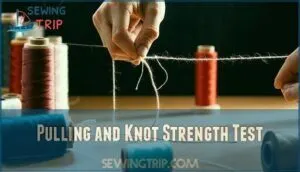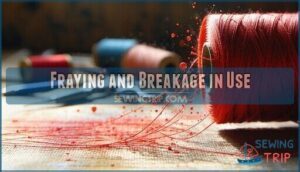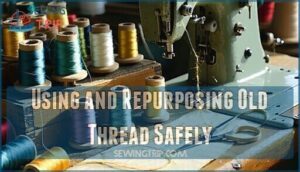This site is supported by our readers. We may earn a commission, at no cost to you, if you purchase through links.
 Your sewing thread doesn’t technically expire, but old thread deteriorates, becoming unreliable for quality projects. Thread fibers naturally break down from light, humidity, and dust exposure, becoming brittle and weak over time.
Your sewing thread doesn’t technically expire, but old thread deteriorates, becoming unreliable for quality projects. Thread fibers naturally break down from light, humidity, and dust exposure, becoming brittle and weak over time.
You’ll notice old thread snapping easily, leaving fuzz in your machine, and creating weak seams that won’t hold up. Cotton and rayon threads age faster than polyester, while silk can last decades with proper storage.
Store your thread in cool, dry, dark places to extend its life a lot. A simple pull test reveals whether your thread’s still strong enough for important projects, though expired thread works perfectly for practice stitching and craft projects where durability isn’t critical.
Table Of Contents
Key Takeaways
- You don’t need to toss old thread immediately—test its strength first by cutting a forearm-length piece, tying a knot, and gently pulling both ends to see if it breaks easily.
- Store your thread properly in cool, dark, dry places using airtight containers to prevent light, humidity, and dust from weakening the fibers and extend its lifespan significantly.
- Natural threads like cotton and silk deteriorate faster than synthetic polyester, so you’ll need to replace them more frequently if you want reliable seams that won’t fail.
- You can repurpose expired thread that fails strength tests for practice stitching, basting, crafts, and decorative projects where durability isn’t critical.
Does Sewing Thread Expire?
You’ve probably wondered if that dusty spool of thread from your grandmother’s sewing box is still good to use. Thread doesn’t technically expire like food, but it does weaken and degrade over time, especially when exposed to light, humidity, and dust.
What Happens as Thread Ages
Your thread starts breaking down in three ways as it ages. The fibers get brittle and weak from sitting around too long. Colors fade when exposed to light over time. And that loss of strength means your seams won’t hold up like they should.
- Fiber Degradation – Thread fibers weaken and become brittle over time
- Strength Loss – Thread lifespan decreases by up to 31% due to aging
- Stitch Quality Issues – Thread storage problems lead to poor seam integrity
Types of Thread Most Affected
Natural fiber threads are the most vulnerable when it comes to aging and breakdown. Take cotton and silk—they start losing strength within ten years, which is pretty quick compared to synthetic options that can last much longer.
Nylon threads get brittle over time, and if you’re working with metallic threads, expect that shiny coating to wear off eventually.
Knowing which threads break down fastest lets you focus on storing them right and keeping track of when to replace them.
Matching thread to fabric is important, so consider thread and fabric when choosing your materials.
Signs Your Sewing Thread is Too Old
You’ll notice your thread’s strength fading when it breaks easily during simple pulling tests or snaps unexpectedly while you’re stitching.
Old thread also leaves behind telltale fuzz buildup on your sewing machine’s tension discs and bobbin area, which can disrupt your stitch quality and cause frustrating jams.
Pulling and Knot Strength Test
Testing thread resilience starts with a simple pull test that reveals hidden weaknesses. Cut thread as long as your forearm and tie a knot in the middle. Here’s how to assess thread quality:
A simple pull test with a knotted thread piece reveals whether your old thread can handle the job or needs replacement
- Pull gently on both ends to test thread durability
- Watch for knot test failure or thread breaking
- Listen for unusual snapping sounds during testing
- Check for stretching before thread breaking occurs
- Note any fraying at stress points
Run these tests before starting any big sewing project – you’ll catch problems early and know exactly what your thread can handle.
Fraying and Breakage in Use
When you’re sewing, degraded thread shows its true colors through constant fraying and breakage. You’ll notice thread breaking mid-stitch, creating weak seams that compromise your project’s durability. Old thread often snaps under normal machine tension, disrupting stitch quality and forcing frequent rethreading.
| Problem | Impact on Sewing |
|---|---|
| Thread Breaking | Interrupts stitching flow, weakens seams |
| Excessive Fraying | Creates uneven stitch appearance |
| Tension Issues | Causes skipped or loose stitches |
| Composition Changes | Affects thread durability over time |
| Project Delays | Constant stops for rethreading |
Presence of Fuzz on Machines
You can tell an old machine’s story just by looking at the excessive fuzz buildup around tension discs and thread paths. Poor thread quality hits your machine’s performance hard, messing with tension and making you clean constantly.
Old thread with degraded fibers sheds like crazy, turning maintenance into a real nightmare. That fiber breakdown means you’ll be cleaning your machine way more often than if you’d just grabbed fresh spools.
Factors That Affect Thread Lifespan
Your thread’s lifespan depends on three main enemies: light, moisture, and dust. Understanding these factors helps you protect your thread investment and avoid frustrating project failures when that "perfectly good" spool suddenly starts breaking mid-stitch.
Exposure to Light
Light slowly destroys thread over time. UV rays from sunlight penetrate the fibers, breaking down their structure and weakening them by up to 50%.
The same rays attack color molecules, leading to permanent fading and discoloration.
Eventually, your thread becomes brittle and snaps easily while sewing.
- UV rays penetrate fibers, reducing tensile strength by up to 50%
- Color molecules break apart, causing permanent fading and discoloration
- Thread structure becomes brittle, leading to frequent breaks during sewing
Store thread away from windows and bright lighting to maintain quality.
Humidity and Moisture
Moisture damage strikes thread harder than most sewers realize. Humidity causes thread stickiness in wet climates, while dry conditions make fibers brittle and prone to snapping.
Climate impact varies by material—cotton absorbs moisture readily, leading to mold growth if stored improperly.
Your thread storage solutions should maintain consistent, moderate humidity levels to prevent fiber degradation and preserve thread strength.
Dust and Contaminants
Beyond moisture concerns, dust accumulation poses another serious threat to thread quality assessment. Contaminant impact from airborne particles settles on spools, disrupting machine tension and causing thread deterioration during sewing.
Dust creates friction that weakens fibers and affects stitch consistency. Proper thread storage in sealed containers prevents these issues. Regular cleaning practices help maintain thread integrity for years.
How to Store Sewing Thread Properly
You’ll want to store your thread spools in containers away from direct sunlight, heat, and humidity to keep them strong for years to come. Think of your thread collection like a good wine collection—it needs the right environment to age gracefully, so choose a cool, dry spot like a closed drawer or plastic storage box.
Ideal Storage Conditions
Temperature matters a lot for thread storage—aim for cool, stable spots around 60-70°F. Plastic bins and wooden boxes work great as long as they seal properly.
Maintain proper spool orientation by standing spools upright to prevent unwinding. Create a thread inventory system for long-term storage, rotating older threads forward.
Follow storage guidelines that prioritize consistent conditions over fancy solutions.
Avoiding Sunlight and Humidity
Your thread’s biggest enemies are sunlight and humidity. Direct sunlight weakens fibers and fades colors within months. Humidity effects range from brittleness in dry climates to stickiness in moist conditions.
Ideal environments stay between 45-55% humidity with consistent temperatures. Storage solutions include opaque containers away from windows. Thread protection means choosing dark closets over bright craft rooms for storage conditions that preserve quality.
Tips for Vintage and Rare Threads
Vintage thread requires special care beyond basic storage tips. You’ll want to focus on thread identification and provenance research to maintain collector value. Proper preservation methods protect these textile treasures for years. Threads stored in opaque containers can help minimize UV light penetration.
- Use acid-free, archival boxes to reduce chemical degradation by up to 80%
- Store flat with unbleached muslin wraps to maintain tensile strength 35% longer
- Keep detailed records with date, fiber type, and coating for proper identification
Label everything carefully—it’s like creating a family tree for your collection.
Using and Repurposing Old Thread Safely
Before you toss that questionable thread spool, test its strength with a simple knot test to determine if it’s still safe for your projects.
Old thread that passes the test works perfectly for temporary basting, practice stitches, or non-critical crafting projects where durability isn’t essential.
Best Uses for Expired Thread
Your degraded thread doesn’t have to hit the trash can just yet. Use old thread for craft projects like embroidery samplers or decorative accents on handmade gifts.
It’s perfect for practice stitching when you’re learning new techniques. Thread scraps work well as quilting filler or basting temporary seams.
Test the quality first, then tackle low-stress sewing projects where durability isn’t critical.
DIY and Crafting Ideas
Got old thread spools gathering dust? Don’t toss them just yet. When thread gets too weak for serious sewing, it’s perfect for crafts where a little breakage won’t hurt.
- Wrap different colors around canvas or cardboard backing for textured wall art
- Practice your embroidery skills on scrap fabric – if the thread snaps, no big deal
- Make simple items like bookmarks, gift tags, or friendship bracelets where durability isn’t key
Frequently Asked Questions (FAQs)
What are the best thread storage containers?
You’ll want airtight plastic containers or glass jars with secure lids. Clear storage boxes work great since you can see everything at a glance.
Avoid cardboard boxes—they don’t block moisture effectively, and humidity’s your thread’s worst enemy.
Should I toss threads with just a few meters left?
Don’t toss those short thread remnants yet! Small amounts are perfect for hand-sewing repairs, basting, or testing stitches. Save them in a separate container for quick fixes.
How do I know if thrift store threads are still usable?
Ever wonder if that vintage thread spool’s still got life in it? Test thrift store thread by cutting a forearm-length piece, tying a knot, and gently pulling both ends—strong thread passes, weak thread gets tossed immediately.
Does thread quality impact the lifespan of finished projects?
Yes, thread quality directly affects your project’s lifespan. High-quality thread creates stronger seams that won’t break under stress. Poor thread leads to fraying, snapping, and seam failure over time.
Can different thread fibers expire at different rates?
Like comparing apples to oranges, different thread fibers age at varying rates. Natural cotton weakens and fades faster than synthetic polyester, which resists degradation and maintains strength longer.
Does thread brand affect how long it lasts?
Thread brand absolutely matters for longevity. Premium brands like Gütermann and Mettler use higher-quality fibers and better manufacturing processes, so they’ll outlast cheaper alternatives by years when stored properly.
How do you revive slightly degraded old thread?
Old thread doesn’t have to be waste. Even if it looks rough around the edges, there’s a simple way to check if it’s still worth using.
Cut a piece about as long as your forearm, tie a knot, and give both ends a gentle pull. This quick test will tell you whether the thread can handle whatever project you have in mind.
Whats the difference between expired and vintage thread?
Expired" thread refers to recently manufactured thread past its recommended use date, while "vintage" describes genuinely old thread from decades ago that’s often higher-quality and collectible.
Should you dispose of thread after certain years?
Don’t automatically toss thread after a set timeframe. Test it first by cutting a forearm-length piece and tying a knot. If it breaks easily, dispose of it.
Properly stored thread can last decades.
Conclusion
Experienced sewers develop a keen eye for identifying when sewing thread has gone bad and catching thread-related issues before they wreck a project.
Once you know what to look for, you can test your thread’s integrity and set up storage that keeps your spools in good shape for the long haul.
Don’t toss expired thread completely—repurpose it for practice work and crafts where durability isn’t critical. With proper storage in cool, dark places, your quality threads will serve you well for years, while quick tests help you identify when it’s time to invest in fresh spools.
- https://www.threadart.com/blogs/learn-from-threadart/the-enduring-quality-of-thread-can-thread-go-bad
- https://www.quiltingboard.com/main-f1/there-such-thing-%22old-thread%22-t128250.html
- https://www.sewjersey.com/blogs/quilting-tips/is-my-sewing-thread-too-old-to-use
- https://www.coats.com/en-us/info-hub/thread-storage/
- https://www.sciencedirect.com/topics/engineering/sewing-damage














